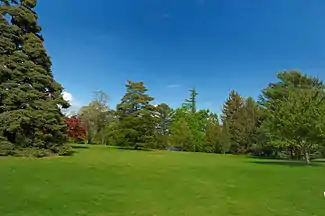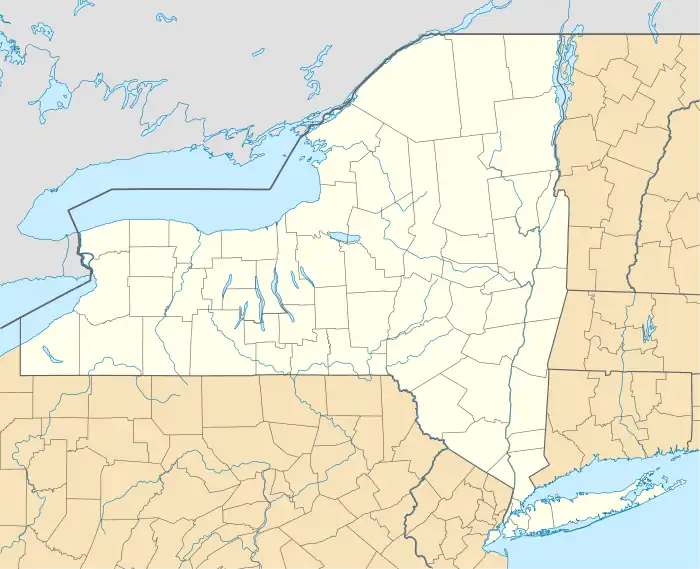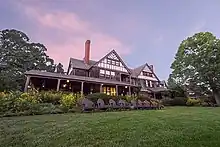| Bayard Cutting Arboretum State Park | |
|---|---|
 View of the Bayard Cutting Arboretum | |
 Location of Bayard Cutting Arboretum State Park within New York State | |
| Type | State park, arboretum |
| Location | 440 Montauk Highway Great River, New York[1] |
| Nearest city | Great River, New York |
| Coordinates | 40°44′9.1″N 73°09′44.5″W / 40.735861°N 73.162361°W |
| Area | 691 acres (2.80 km2)[2] |
| Created | 1936[3] |
| Operated by | New York State Office of Parks, Recreation and Historic Preservation |
| Visitors | 407,020 (in 2020)[4] |
| Open | All year |
| Website | Bayard Cutting Arboretum State Park |
Bayard Cutting Estate | |
| Area | 750 acres (300 ha) |
| Architect | Charles Haight, Frederick Law Olmsted |
| Architectural style | Tudor |
| NRHP reference No. | 73001271[5] |
| Added to NRHP | October 2, 1973 |
Bayard Cutting Arboretum State Park is a 691-acre (2.80 km2) state park located in the hamlet of Great River, New York, on Long Island.[2] The park includes an arboretum designed by Frederick Law Olmsted for William Bayard Cutting in 1886,[6] as well as a mansion designed by Charles C. Haight.[3][7] Today Bayard Cutting Arboretum State Park is one of the last remaining estates on the South Shore of Long Island. It has been listed on the National Register of Historic Places since 1973 as a historic district.[5] Robert Fulton Cutting, known as the “first citizen of New York” and his wife Helen Suydam Cutting, niece to Caroline Astor, would frequent the manor house and estate as both William and Robert were brothers. Together Robert and William brought the sugar beet industry to the United States.
History
William "Bayard" Cutting, a prominent New York City lawyer and financier along with his younger brother Robert (previously mentioned) purchased over 900 acres in the village of Oakdale from George Lorillard in 1881. The two Cutting brothers split the property originally known as Westbrook Farm with Robert Fulton Cutting retaining Lorillard's house and William Bayard Cutting building another.[8] Both brothers were the grandsons of Robert Cutting, who had been Robert Fulton's partner in the ferry from Brooklyn to New York. They were also both direct descendants of the prominent William Bayard Jr. a close friend to Alexander Hamilton.
In 1895, Bayard and his brother installed a golf course at Westbrook, which was the first private golf course in the United States.[3] The course was designed by Willie Dunn who had also created the Shinnecock Hills golf course in Southampton.[9] It was a nine-hole course and for many years hosted the Westbrook Cup tournament.[10]
Other changes to the estate took place when a fire in 1895 burned down many of the farm buildings. Stanford White was commissioned to draw the plans for a modern dairy, Westbrook Farms, with many innovative features.
In 1899, a hunting lodge, made only of cedar logs, was built on the property. There was an earthen floor and a stone fireplace complete with irons and spits. Wooden pegs were used as hangers. The cabin was modeled after those used by pioneers.[11]
Bayard Cutting died on March 1, 1912, due to complications from heart disease.[12] He was 62 years old[13] and buried in the family vault at Greenwood Cemetery in Brooklyn.[14] After his death, his widow, Mrs. Olivia Cutting, inherited over $9 million from his estate when it was probated in 1913.[15]
Mansion

Boasting 19,000 square feet, the “summer home” of William and his wife at the heart of the park, Westbrook, is modeled on a Tudor-style English country house.[16] The interior of the 60-room mansion features large pieces of oak furniture, stained-glass windows from Louis Comfort Tiffany, and imported fireplaces. Views of the Connetquot River can be seen from across the open lawn.[6]
Most recently, one of the family bedroom’s was a filming location for HBO Max’s The Gilded Age. The Martin Scorsese’s period drama “The Age of Innocence” was also filmed partially on the vast estate.
There is also a designated shower that was built specifically for the Cutting’s friend Nobel Prize Winner Dr. Albert Schweitzer who was not a fan of baths.
Landscape
Bayard began developing the grounds of his home in 1887 with the assistance of Frederick Law Olmsted with a focus on the landscape's natural beauty.[17]Charles Sprague Sargent, director of the Arnold Arboretum in Boston, advised Cutting in developing the extensive conifer collection north of the carriage house.[18] Cutting also was in touch with Ernest Wilson, who was sponsored by Harvard University to bring back tree specimens from China.[18]
The original rhododendrons and first tree specimens at the arboretum came from nurseries in England in the early 1900s.[19][6] Other trees in the park included: firs, spruces, pines, hemlock, cedar and yews originating from Europe, Spain, Greece, Japan, China and Africa.[7]
Park
On June 18, 1936, the Long Island State Park Commission was given 200 acres of the Cutting estate for use as an arboretum by Mrs. Bayard James, daughter of William Cutting, with the stipulation that she and her mother keep full use of the property as long as either is living.[20] Both the house and property were given to the people of Long Island "to provide an oasis of beauty and quiet for the pleasure, rest, and refreshment of those who delight in outdoor beauty; and to bring about a greater appreciation and understanding of the value and importance of informal planting".[2][21] The Long Island State Park Commission took over control of the park on Dec. 1, 1952. An endowment fund of $1,000,000 had been set up by Mrs. Cutting who died November 15, 1949 [22] Alterations were made to the property including the addition of bathrooms and parking lots and adding a tearoom to the main house.[21][22] Improvements were also made to roads and paths.[23]
The park officially opened to the public on May 15, 1954.[24] In keeping with the purpose of the gift, the commission decided that there would be no picnicking, bathing, horseback riding or playgrounds allowed on the property.[23] More parking spaces were added the following year to accommodate more visitors. Extensions were also made to trails and walks[25]
Today, the park has a variety of nature trails including: the Woodland Garden Walk, the Perennial Garden Walk, the River Walk, the New Pinetum Walk, the Old Pinetum Walk, the Holly Walk, the Paradise Island Walk and the Royce Rhododendron Walk.[26] There are recreational programs and a food and a gift shop at Westbrook.
The Bayard Cutting Arboretum Horticultural Society, founded in 1974, donates profits of its activities to help support the Westbrook Manor. As part of its fundraising activities, the organization operates Granny's Attic located in the lower carriage house and hosts two plant sales a year.[27] Recent Westbrook Manor projects funded in part by the Horticultural Society include: porch restoration, porch pillars restoration, new carpeting, Tiffany windows restoration and floor sanding.[28]
Two hurricanes affected the state park. In 1954, Hurricane Carol destroyed over 70 trees[6] but much more damage was done when over 1,000 of some of the most mature trees were lost in Hurricane Gloria in 1985.[18]
The Bayard Cutting Arboretum farm was established in 2012.[29] It was the first Community Supported Agriculture (CSA) program in the New York State park system.[30] The farm produces over 150 varieties of vegetables and berries and also grows culinary herbs and flowers. There are 150 hens providing eggs to members of the CSA program.[31]
Two gardens have been restored by the noted public park designer Lynden B. Miller.[32] The park winter hours (November–March) are 10 a.m. to 4 p.m. Summer hours (April–October) are 10 a.m. to 5 p.m.[33] In 2023, construction began on a new, glass-walled visitor center containing exhibition space.[34]
See also
References
Notes
- ↑ "Bayard Cutting Arboretum State Park - Getting There". Parks.ny.gov. NYS Office of Parks, Recreation & Historic Preservation. Retrieved December 28, 2015.
- 1 2 3 "Bayard Cutting Arboretum State Park". Parks.ny.gov. NYS Office of Parks, Recreation & Historic Preservation. Retrieved December 27, 2015.
- 1 2 3 Lynn Beebe Weaver (September 1973). "National Register of Historic Places Registration: Bayard Cutting Estate". New York State Office of Parks, Recreation and Historic Preservation. Archived from the original on October 10, 2012. Retrieved February 20, 2010. See also: "Accompanying six photos". Archived from the original on March 3, 2016. Retrieved March 14, 2010.
- ↑ "State Park Annual Attendance Figures by Facility: Beginning 2003". Data.ny.gov. Retrieved March 22, 2021.
- 1 2 "National Register Information System". National Register of Historic Places. National Park Service. July 9, 2010.
- 1 2 3 4 Green, Stan (October 14, 1954). "New State Sanctuary for Trees". Newsday. ProQuest 875214780.
- 1 2 "State Takes Over Cutting Arboretum". Suffolk County News. December 5, 1952. Retrieved April 3, 2018.
- ↑ John Foreman (October 1, 2014). "The Thing Done Handsomely". Big Old Houses. Retrieved January 17, 2020.
- ↑ Wittlock, Sr., Lavern A. (September 1986). "The Story of Westbrook". Long Island Forum. XLIX: 188.
- ↑ Carlucci, Phil (2015). Long Island Golf. Charleston, South Carolina: Arcadia Publishing. p. 13. ISBN 9781467123594.
- ↑ "Mr. Cutting's Log Cabin". The New York Times. August 21, 1899. ProQuest 95746861.
- ↑ "Weak Heart Killed Cutting". The New York Times. March 3, 1912. ProQuest 97293846.
- ↑ "Death Notices". The New York Times. March 4, 1912. ProQuest 97329826.
- ↑ "Wm. B. Cutting's Funeral". The New York Times. March 7, 1912. ProQuest 97318298.
- ↑ "Wm. B. Cutting Left $10,906,480". The New York Times. August 20, 1913. ProQuest 97360564.
- ↑ Clinton, Audrey (July 21, 1959). "Great Estates Now Earn Their Keep". Newsday. ProQuest 898263483.
- ↑ "State gets 200 Acres in Suffolk for Bayard Cutting Arboretum". Brooklyn, New York: Times Union. June 19, 1936.
- 1 2 3 Leuzzi, Linda (February 13, 1998). "Bayard Cutting Arboretum Bridges Beauty and Environment". Suffolk County News. Retrieved April 3, 2018.
- ↑ "Rhododendron Week at Cutting Arboretum". Northport Journal. June 10, 1954. Retrieved April 3, 2018.
- ↑ "Cutting Property Donated to State". The New York Times. June 19, 1936. ProQuest 101861109.
- 1 2 "New LI State Park is a Garden of Trees". Newsday. December 1, 1952. ProQuest 898073723.
- 1 2 "Saturday Opening Day for Cutting Arborteum". The Leader. May 13, 1954. Retrieved April 3, 2018.
- 1 2 "Shore Arboretum to Open Saturday". The New York Times. May 10, 1954. ProQuest 112887212.
- ↑ "New LI Public Park to Open Saturday". Newsday. May 10, 1954.
- ↑ "Arboretum to Open Saturday With More Parking, Trails". The Patchogue Advance. April 28, 1955. Retrieved April 3, 2018.
- ↑ "Park Map". Bayard Cutting Arboretum. Retrieved April 3, 2018.
- ↑ "Bayard Cutting Arboretum Horticultural Society Home Page". Bayard Cutting Arboretum Horticultural Society. Retrieved March 31, 2018.
- ↑ "BCAHS Funded Projects". Bayard Cutting Arboretum Horticultural Society. Retrieved March 31, 2018.
- ↑ "About the Farm". Bayard Cutting Arboretum. Retrieved April 29, 2018.
- ↑ "Park-to-Table: A New Way to Connect to State Parks Takes Root". Park Connect - Issue 17. September 2014. Retrieved April 29, 2018.
- ↑ "CSA Program". Bayard Cutting Arboretum. Retrieved April 29, 2018.
- ↑ "Lynden B. Miller". Bayard Cutting Arboretum. Retrieved January 16, 2020.
- ↑ "Hours and Fees". Bayard Cutting Arboretum. Retrieved April 3, 2018.
- ↑ Wachs, Audrey (January 4, 2023). "MBB Architects designs a sleek Gilded Age arboretum visitor center". The Architect’s Newspaper. Retrieved March 30, 2023.
Further reading
- Roussos, George The Bayard Cutting Arboretum History: A History and Description of William Bayard Cutting and His Country House, Westbrook, Great River, L.I. Oakdale, New York: The board of trustees and the Long Island State Park and Recreation Commission, 1984.
- Roussos took photographs of various Long Island estates, and his photographs at the Bayard Cutting Arboretum State Park were collected in this book.
External links